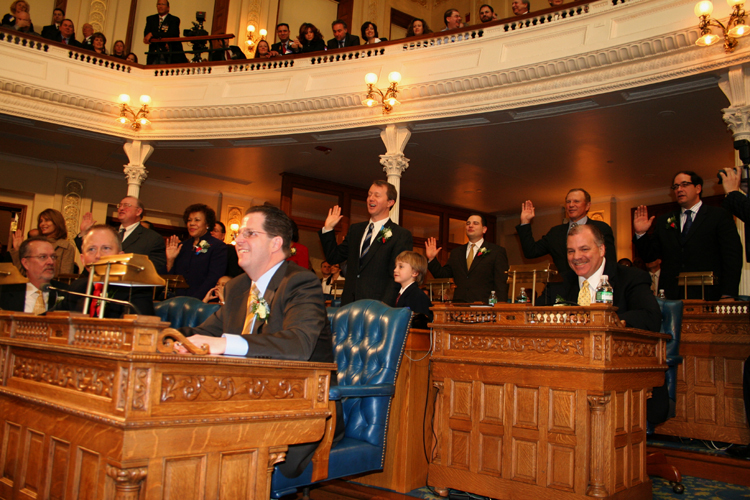
TRENTON – Legislation sponsored by Senator Bob Smith and Senate President Steve Sweeney that would stave off future economic crashes in New Jersey’s solar market, encourage development of solar installations in the state, and provide a boost in solar-related jobs was approved today by the Senate Environment and Energy Committee.
“Solar power has become so popular in New Jersey that the supply of solar energy has grown faster than the demand from energy companies – who are required to purchase a minimum amount of their energy from solar supplies each year,” said Senator Smith, D-Middlesex, Chairman of the Environment and Energy Committee. “Rather than allowing this market’s growth to stagnate and the production of clean and domestically-produced solar energy to slow, we need to continue to supply incentives for New Jerseyans to purchase and install solar equipment, while keeping costs down for electric ratepayers. This bill is a great step in avoiding another bust of New Jersey’s solar market.”
“As the solar industry has boomed over the past few years in New Jersey, it has become an economic engine for good, well-paying construction and installation jobs throughout the state. But with the dramatic fall of solar energy incentive prices, there is a serious concern that development and installation of solar systems will dry up and these jobs will be lost,” said Senate President Sweeney, D-Gloucester, Cumberland, Salem. “This legislation will stabilize the market and encourage businesses and individuals to continue to purchase and install solar equipment on their property.”
The bill, S-1925, would alter the multi-year schedule which dictates the amount of solar energy that electric energy suppliers must purchase each year.
New Jersey, which is second in the nation in solar energy production, has seen a boom-and-bust in solar energy development in the past few years. According to Flett Exchange, an energy brokerage firm, the price of solar renewable energy certificates (SRECs) – or certificates representing one mega-watt-hour of electricity generated from a solar energy installation, whether it is a household rooftop panel or a solar farm – reached an all time high of nearly $700, only to plummet to its lowest rate of under $90 this past month, as a mass increase of new solar installations have entered the market.
The Senators note that by increasing the demand for solar energy by increasing the amount that the energy companies must purchase, the state can continue to encourage development of solar installations and provide new life to the solar job market that includes both manufacturing and installation in New Jersey. According to the Mid-Atlantic Solar Energy Industries Association, there are more than 10,000 New Jerseyans working in the solar industry.
“By stabilizing the solar industry we can encourage growth in the green economy jobs sector in the state,” said Senate President Sweeney. “We must provide continued job security and growth for the men and women who are charged with installing these systems on people’s rooftops and on solar farms across New Jersey. That is truly what this legislation is about.”
The bill would also create a de facto cost ceiling schedule on the price of SRECs starting with $325 per certificate in energy year 2014 in order to keep the purchasing price of the SRECs reasonable so that energy suppliers will not have to pass on booming SREC costs to the ratepayers.
The bill would allow for school districts, counties and municipalities to virtual net-meter. Currently, a solar installation can only produce power for the building it is attached to and then receive SRECs for additional energy produced that has been pushed back into the energy grid. By virtual net metering, school districts, counties and municipalities can receive credits for this overage of energy produced by its solar panels to pay for energy used by non-connected buildings under their jurisdiction. Senator Smith and Senate President Sweeney note that this will help municipalities keep their energy costs low, which in turn will affect their overall budgets and avert future property tax increases.
“We are finding new and innovative ways to reduce costs to municipalities and counties across New Jersey and virtual net-metering is another example of that,” said Senator Smith. “By allowing entities to use credits from extra solar energy produced from one building in their community to pay the electric bills for other buildings and facilities in their community, we are creating cross town and cross county savings that will be directly reflected in municipal and county budgets.”
Finally, the bill would provide an oversight provision to review solar installations that are not net-metered, but still wish to receive SRECs. An example of a net-metered site is a house, office or other facility that generates electricity via solar equipment for its own use, with the surplus electricity fed back into the electric grid to earn credit. Non-net-metered sites produce electricity directly into the grid, and do not use electricity produced by solar equipment for the facility’s use. An example of a non-net-metered site would be a power station or large-scale solar farm.
The bill would provide that the first 80 megawatts of non-net-metered solar projects to be installed during the energy years of 2014 to 2016 (June 2013 to May 2016) would not require New Jersey Board of Public Utility (BPU) oversight. Any project over that first 80 megawatts, no matter the size of the individual project, would require BPU approval which would be determined based on the project’s effect on the statewide SREC market, the environmental impact of building the installation and the benefit to electric rates and economic development. After energy year 2016, all non-metered solar installations would require BPU approval. Solar installations built on brownfield remediation sites and landfills would not be required to receive BPU approval.
The bill was approved by the Senate Environment and Energy Committee with a vote of 3-0-1. It now heads to the full Senate for consideration.



